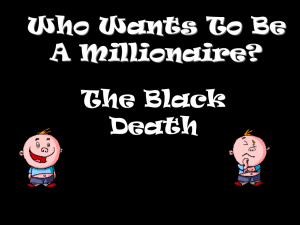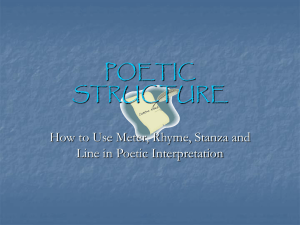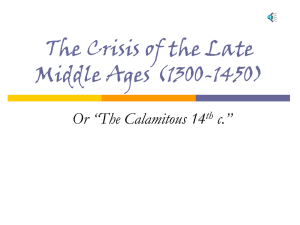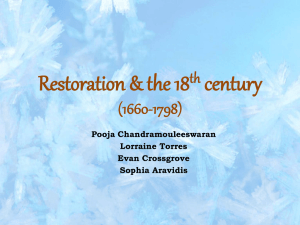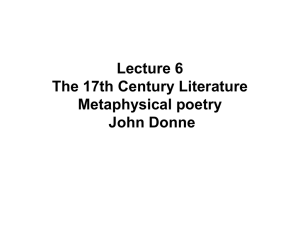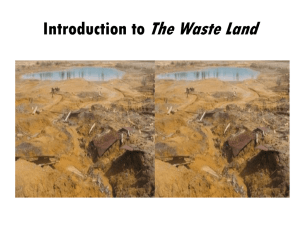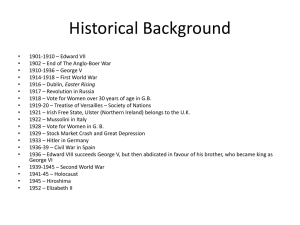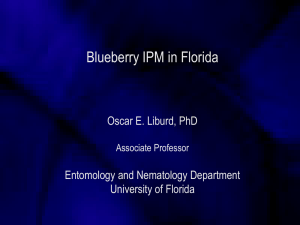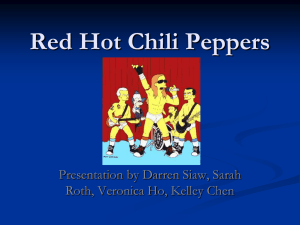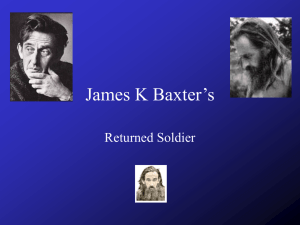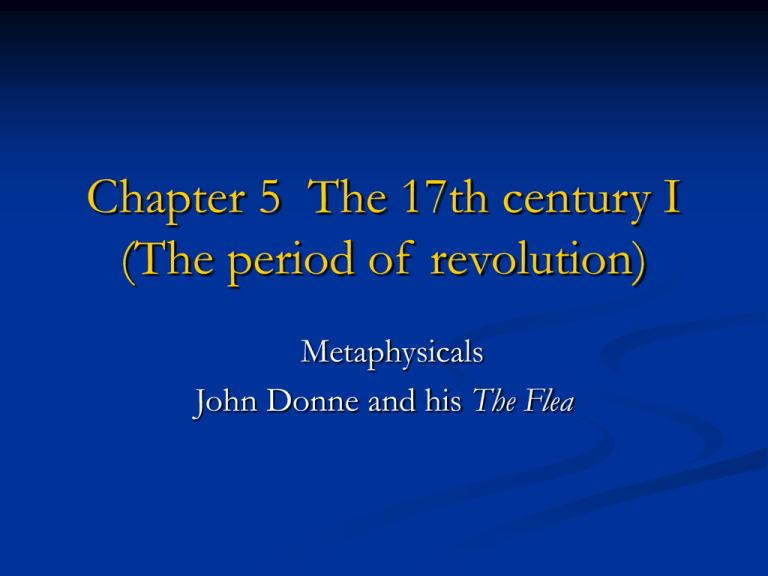
Chapter 5 The 17th century I
(The period of revolution)
Metaphysicals
John Donne and his The Flea
Contents
1.
2.
3.
4.
5.
Historical Background
Literary features in this period
Metaphysicals
John Donne
Life experience
Literary career
Major works and Artistic features
His creations in poetry
Appreciayion if his The Flea
Historical background
Conflicts between the king and the
Parliament
The outburst of the civil war (the revolution)
Restoration and the Glorious Revolution
The changes of values and thoughts of
people and the society
Conflicts between the king and the
Parliament
The religious aspect of the chaos
1. King James I came to power in 1603 and began
to impose his will upon religious matters as well
as on Parliament.
2. But an extreme Protestant sect would like to see
the church more free of the control of the state
and restored to the purity of the first century
church of Jesus Christ.
1.
2.
The political aspect of the chaos
The King saw Parliament as his servant, but
Parliament refused to take his orders without
good reason. The King then decided to dissolve
it and ruled the country in his own for seven
years (1614 – 1621).
His successor Charles I claimed his rule as a
divine right, but Parliament saw him as a human
being. This led to the dissolution of the first
three parliaments and also the fourth .The dead
lock was not to be addressed except the war.
The outburst of the civil war (the
revolution)
The civil war broke out. For a few years (1642 – 1648)
it raged between Parliament with its army of the
“Roundabouts” on one side and the King with his
Cavaliers on the other, ended with the capture and the
beheading of Charles I and the founding of the
commonwealth in 1649.
Oliver Cromwell (1599 – 1658) and his ironsides
moved in, and England became a Protectorate with
Cromwell as its Protector.
Restoration and the Glorious
Revolution
With the death of Cromwell, the Parliament asked
Charles II, Charles I’s son to the throne. Thus
began the Restoration in 1660. The country again
fell into the anarchy. But he was clever enough to
agree act as a figurehead and not to enrage
Parliament.
The James II, his brother, tried once more to rule
absolutely and restore the Roman Catholic religion.
Parliament felt insecure and invited his brother-in-law,
William Orange, in 1688 to come with an army to
protect the English people. This was the “Glorious
Revolution”, glorious because bloodless.
The Bill of Rights which the new king signed with
Parliament endowed Parliament as the de facto ruler of
the nation and the king became a titular head.
Now the struggle between king and Parliament came to
an end, and no king or queen has ever again thought of
competing with Parliament.
The changes of values and thoughts
of people and the society
The old value system was on its way out; the
new values were taking shape. People and the
society all had the attempt to seek certainty and
intellectual harmony, and to address the question
of values through violence and sexuality. These
incidentally constituted the features of the
period.
Literary features in this period
The literary mood: a mood of gloom,
pessimism, decadence, and frivolity.
The literary scene: not prolific; and because
there was no accepted standard in government
and religion, there was no fixed standard of
literary criticism; and some of the literary works
were influenced by French culture.
So there appeared an influential school of
literature, Mataphisicals in this period.
Metaphysicals /Metaphysics
Metaphysicals (a literary term): It is a school of
poets in England, appearing in the 17th century.
The Metaphysical poets tended to emphasize
their personalities and the complexity of their
intellect. Their works are just a mixture of poet’s
emotions and intellect. Generally speaking, their
works are characterized by mysticism in content
and fantasticality in form.
Founder of Metaphysical poetry: John Donne
is regarded as the founder of Metaphysical poetry
Representatives of Metaphysical poets (read
P75): George Herbert, Henry Vaughan, Richard
Crashaw etc..
The basic features of Metaphysical poetry: Wits
Or conceits(p76)
John Donne (1571 – 1631)
Life experience: (P74)
His literary career: Donne’s literary career can
be divided into two periods.
1. 1st period: Most of The Elegies and Satires and a
good many of the Songs and Sonnets were written.
2. In the later period: he mainly wrote religious
poems and prose works, esp. sermons, which
reveal his spiritual devotion to God as a
passionate preacher.
His major works,
1. Two categories of his poetry
1.1 The youthful love lyrics: The Songs and Sonnets
(1633), by which Donne is probably the best known,
contains most of his early lyrics. Love is the basic theme.
Donne holds that the nature of love is the union of soul
and body. These poems are very good examples of
Metaphysical poetry. What is more, idealism and
cynicism about love coexist in Donne’s love poetry. (read
p77 -78)
1.2 The sacred verses (religious poems): published in 1624
as Devotion Upon Emergent Occasions.
2. Major artistic features:
2.1 In his poetry, he frequently applies conceits, i.e. extended
metaphors involving dramatic contrasts. His conceits may be
divided into two kinds; easy ones and difficult ones.
2.2 His poetry involves a certain kind of argument with the direct,
simple, sharp and heart-searching language. It begins with a certain
idea but ends in quite a contrary one.
2.3 His great prose works are both rich and imaginative, exhibiting the
same kind of physical vigor and scholastic complexity as his poetry.
2.4 His best work is uneven in quality (p79): some are of highest
order with noble themes, but some are mere doggerel expressions
of trivialities. Its imagery and thoughts can be licentious, and its
form rugged and lacking in smoothness.
2.5 His writing style: frank and penetrating realism.
His creations in poetry:
1. He abandons the traditional form of sonnets,
and gives a verse or a stanza a flexible form
according to the peculiar theme.
2. He gives up the traditional skill of illustrating the
theme in the poem, but has his own ways of
fantastic metaphors and extravagant hyperboles
to express his theme or ideas.
Analysis and appreciation of The Flea
The Title: Donne’s “The Flea” is a seduction poem in
which the author presents the title insect to his lover as a
symbol of the potential consummation of their relationship.
Stanza I
Lines 1-2: The speaker tells his beloved to look at the flea before
them “Take note of this.” With the word “but,” he seems to
discount the worthiness of the flea, it is just an insect.
Continuing on, he mentions, “mark in this,” which draws the
reader’s attention from the body of the flea to the interior of
the flea and to note "how little" is that thing that she denies him
(refusing his wooing love/his proposing sex with her)
Lines 3-4: For the flea, he says, has sucked first his
blood, then her blood, so that now, inside the flea,
they are mingled; By diminishing the importance
of the flea, and then the blood inside the flea,
Donne diminishes the importance of his lover’s
virginity. (Although you have refused my wooing
love, our blood has finally mixed together in the
flea. We are together in another way. Your
virginity is not kept.)
“blood” here is a symbol of “sex” and “virginity”.
Lines 5-6: That mingling cannot be called "sin, or shame, or
loss of maidenhead." (why?) Most religions consider
premarital sex a sin and society shames those that are
known to have participated in that act. Premarital sex is
equivalent to the “loss of maidenhead” since “maidenhead”
is an archaic word for the hymen. The word “or” is
problematic. It implies that the tryst that Donne is
suggesting would be considered one of those three
possibilities, instead of being all three at the same time, as
it is commonly viewed. In fact, it would be impossible for
one of the other two choices to occur without the “loss of
maidenhead.” Donne seems to be supplementing his
argument by making the consequences of sex with him
appear less severe.
Lines 7-8: He is asking why the flea can partake of the
sweetness of his lover while he cannot. Since the flea
receives this prize with no effort, it is therefore
“pampered”. Donne says that the flea “swells” with pride.
(Here “swells” implies after sex with someone and then “to
be pregnant”with their mingled blood.)
Line 9: Donne ends the first section of the poem with a cry
of regret. “Alas” shows his true dismay at knowing that
he cannot enjoy the same privilege as the flea, and that he
and his lover cannot consummate their relationship.
This stanza pave the way to the second stanza, the most
famous stanza of “conceits”.
Stanza II
Line 1-2: As his beloved moves to kill the flea, the speaker
stays her hand, asking her to spare the three lives in the
flea: his life, her life, and the flea's own life.
When he writes, “three lives in one flea spare,” he is
saying that the fluid inside the flea is not just
blood, but also he and his lover. Their lives are
contained within the flea. The flea is the first life,
and they are the additional two(an insect, spare it,
please). Here “three lives in one flea” is a metaphor.
Lines 3-4: Here is Donne’s second metaphor of this stanza
comparing the flea to a “marriage bed and marriage
temple”. This emphasizes the intimate nature of the
mingling of blood presented earlier. The flea is a place
where the two lovers can have a marital relationship. In
fact, they “more than married are”. In the flea, he says,
where their blood is mingled, they are almost married-no, more than married--and the flea is their marriage bed
and marriage temple mixed into one.
Here “conceits”: Flea>Church/marriage temple>Flea
Flea>marriage bed>Flea
Lines 5-6: Donne presents the idea of social conventions
when he says that “parents grudge, and you”. The parents
are representative of the society that says that premarital
sex is a sin. Though their parents grudge their romance
and though she will not make love to him, they are
nevertheless united and cloistered in the living walls of the
flea.
Lines 7-9: She is apt to kill him, he says, but he asks that she
not kill herself by killing the flea that contains her blood;
he says that to kill the flea would be sacrilege, "three sins
in killing three."(What does “three” make you think of
according to The Bible? Here understanding it as the holy
religious images: trinity.)
Stanza III
"Cruel and sudden," the speaker calls his lover, who has
now killed the flea, "purpling" her fingernail with the
"blood of innocence." The speaker asks his lover what
the flea's sin was, other than having sucked from each of
them a drop of blood. He says that his lover replies that
neither of them is less noble for having killed the flea. It
is true, he says, and it is this very fact that proves that her
fears are false: If she were to accept his wooing ("yield to
me"), she would lose no more honor than she lost when
she killed the flea.
The structure of the poem:
This poem alternates metrically between lines in iambic
tetrameter and lines in iambic pentameter, a 4-5 stress
pattern ending with two pentameter lines at the end of
each stanza. Thus, the stress pattern in each of the nineline stanzas is 454545455. The rhyme scheme in each
stanza is similarly regular, in couplets, with the final line
rhyming with the final couplet: AABBCCDDD.
The poem is organized into three stanzas of nine lines
each. Each of these stanzas deals with a different aspect
of Donne’s argument.
Assignments
Written work
1.
Define the term: Metaphysicals
2.
Tell the two categories of John Donne’s potery and his masterworks.
3.
In The Flea by John Donne, there are religious images. List them out.
4.
In The Flea by John Donne, What is “blood” symbolized?
5.
In the second stanza of The Flea by John Donne, there are two big metaphors. What
are they? What do they mean? What are the most famous conceits?
6.
Who are the three lives in the flea?
Topics for discussion
1.
What are the literary features in the 17th century?
2.
What are the major artistic features of John Donne?
3.
Discuss John Donne’s literary carrer.
*Oral work
Memorizing John Donne’s The Flea.
Love ends with nothing (a song inserted)

